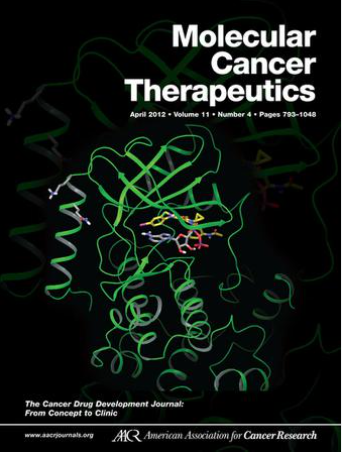摘要 A008:糖尿病前D-葡萄糖暴露会促进EOC进展和顺铂耐药:BAD相关通路的作用及潜在治疗策略
IF 5.3
2区 医学
Q1 ONCOLOGY
引用次数: 0
摘要
糖尿病前期是指血糖水平超过正常临界值(>7 毫摩尔),但尚未达到 2 型糖尿病的诊断标准(<11 毫摩尔)。它与上皮性卵巢癌(EOC)女性患者无进展生存期和总生存期的缩短呈正相关。这表明与糖尿病前期相关的潜在代谢状态可能会促进肿瘤的生存和发展。此外,糖尿病前期还与 EOC 患者的复发风险增加和生存结果较差有关,可能会促进肿瘤的侵袭性和对治疗的耐受性,但其确切机制仍不清楚,需要进一步研究。在本研究中,我们旨在探讨糖尿病前 D-葡萄糖水平是否会加速 EOC 的进展,并阐明其潜在机制。我们还旨在提出一种针对 EOC 进展的可行且有效的治疗策略。我们使用了各种体外和体内致癌试验来评估糖尿病前 D-葡萄糖水平对 EOC 细胞的影响。研究发现,D-葡萄糖能以剂量依赖的方式刺激 EOC 细胞的致癌表型。与暴露于较低剂量(4 毫摩尔)D-葡萄糖的 EOC 细胞相比,暴露于糖尿病前期水平 D-葡萄糖(8 毫摩尔)的 EOC 细胞表现出更高的细胞存活率、更强的单层病灶形成能力、在软琼脂中的生长能力、在三维 Matrigel(体外培养)中的球形形成能力、更强的迁移和侵袭能力以及对顺铂的抗性。暴露于8mM D-葡萄糖会导致与顺铂抗性相关的代谢改变,包括D-葡萄糖消耗增加、ATP生成增加、产热增加、糖酵解能力增强以及线粒体活性增强。RNA 测序分析表明,BCL-2 相关死亡启动子(BAD)通路与 8mM EOC 细胞的代谢改变呈正相关。糖尿病前期的 D-葡萄糖水平上调了 BAD 在丝氨酸(S)99 残基的磷酸化,同时上调的还有 ALDH1A1、HK2、PFKP、G6PD 和 LDHA 等关键代谢酶。用 2-脱氧-D-葡萄糖(2-DG)抑制糖酵解会减弱 8mM D-葡萄糖的作用。此外,强制表达磷酸化的 BADS99 会增加 EOC 的致癌表型。在EOC中观察到与BADS99磷酸化相关的代谢酶活性升高,而去磷酸化的BADS99则会减弱这种效应。高通量筛选发现,BADS99 磷酸化抑制剂和 HDAC 抑制剂的联合疗法在刺激 EOC 细胞凋亡方面具有更高的协同作用。BADS99-HDAC 联合抑制可协同增强 HDAC 抑制剂的疗效,显著降低其 IC50 值。它损害了细胞的存活率、活力、锚定依赖性生长、线粒体活性、能量产生、在三维 Matrigel 中的生长,并成功克服了 EOC 细胞系和一个患者衍生细胞系(AFC)的顺铂耐药性。这种协同治疗方法为利用合成致死性治疗 EOC 患者提供了一种前景广阔的策略。引用格式:黄晶、张茜、黄鹏、巴萨帕-巴萨帕、朱涛、彼得-E-洛比、维杰-潘迪。糖尿病前D-葡萄糖暴露促进EOC进展和顺铂耐药:BAD相关通路的作用及潜在治疗策略[摘要]。In:AACR 癌症研究特别会议论文集:扩展和转化癌症合成脆弱性;2024 年 6 月 10-13 日;加拿大魁北克省蒙特利尔。费城(宾夕法尼亚州):AACR; Mol Cancer Ther 2024;23(6 Suppl):Abstract nr A008.本文章由计算机程序翻译,如有差异,请以英文原文为准。
Abstract A008: Pre-diabetic D-glucose exposure promotes EOC progression and cisplatin resistance: Role of BAD associated pathway and potential therapeutic strategy
Prediabetes denotes a condition when blood sugar levels exceed normal thresholds (>7mmol) but have not reached the diagnostic criteria for type 2 diabetes (<11mmol). It positively correlates with diminished progression-free survival and overall survival among women with epithelial ovarian cancer (EOC). This suggests a potential metabolic state associated with prediabetes that may facilitate tumor survival and progression. Moreover, prediabetes is also associated with an increased risk of recurrence and poorer survival outcomes of EOC patients, possibly promoting tumor aggressiveness and resistance to treatment, although the precise mechanisms remain unclear and warrant additional investigation. In this study, we aimed to explore whether prediabetic D-glucose levels accelerate EOC progression and elucidate underlying mechanisms. We also aimed to propose a viable and effective therapy strategy for EOC progression. Various in vitro and ex vivo oncogenic assays were used to assess the effects of prediabetic levels of D-glucose in EOC cells. It was found to stimulate oncogenic phenotypes in EOC cells in a dose-dependent manner. EOC cells exposed to prediabetic levels of D-glucose (8mM) exhibited increased cell survival, enhanced foci formation on monolayer, growth in soft agar, spheroid formation capacity in 3D Matrigel (ex-vivo culture), increased migration and invasion, and resistance to cisplatin compared to those exposed to lower D-glucose doses (4mM). Exposure to 8mM D-glucose led to metabolic alterations associated with cisplatin resistance, including increased D-glucose consumption, elevated ATP production, increased thermogenesis, enhanced glycolytic capacity, and augmented mitochondrial activity. RNA sequencing analysis showed the BCL-2-associated death promoter (BAD) pathway positively correlates with metabolic alterations of EOC cells in 8mM. Prediabetic levels of D-glucose upregulated phosphorylation of BAD at serine (S) 99 residue along with key metabolic enzymes such as ALDH1A1, HK2, PFKP, G6PD, and LDHA. Inhibition of glycolysis with 2-deoxy-D-glucose (2-DG) attenuated 8mM D-glucose effects. Furthermore, forced expression of phosphorylated BADS99 increased oncogenic phenotypes of EOC. The elevated activities of metabolic enzymes associated with BADS99 phosphorylation were observed in EOCs, while this effect was diminished with dephosphorylated BADS99. High-throughput screening identified a combination therapy involving a BADS99 phosphorylation inhibitor and HDAC inhibitors demonstrated higher synergy to stimulate apoptosis in EOC cells. The combined BADS99-HDAC inhibition synergistically enhanced the efficacy of HDAC inhibitors, significantly reducing their IC50 values. It impaired cell survival, viability, anchorage-independent growth, mitochondrial activity, energy production, growth in 3D Matrigel and successfully overcome cisplatin resistance of EOC cell lines and a patient-derived cell line (AFC). This synergistic therapeutic approach offers a promising strategy for exploiting synthetic lethality in treating EOC patients.
Citation Format: Jing Huang, Xi Zhang, Peng Huang, Basappa Basappa, Tao Zhu, Peter E. Lobie, Vijay Pandey. Pre-diabetic D-glucose exposure promotes EOC progression and cisplatin resistance: Role of BAD associated pathway and potential therapeutic strategy [abstract]. In: Proceedings of the AACR Special Conference in Cancer Research: Expanding and Translating Cancer Synthetic Vulnerabilities; 2024 Jun 10-13; Montreal, Quebec, Canada. Philadelphia (PA): AACR; Mol Cancer Ther 2024;23(6 Suppl):Abstract nr A008.
求助全文
通过发布文献求助,成功后即可免费获取论文全文。
去求助
来源期刊
CiteScore
11.20
自引率
1.80%
发文量
331
审稿时长
3 months
期刊介绍:
Molecular Cancer Therapeutics will focus on basic research that has implications for cancer therapeutics in the following areas: Experimental Cancer Therapeutics, Identification of Molecular Targets, Targets for Chemoprevention, New Models, Cancer Chemistry and Drug Discovery, Molecular and Cellular Pharmacology, Molecular Classification of Tumors, and Bioinformatics and Computational Molecular Biology. The journal provides a publication forum for these emerging disciplines that is focused specifically on cancer research. Papers are stringently reviewed and only those that report results of novel, timely, and significant research and meet high standards of scientific merit will be accepted for publication.

 求助内容:
求助内容: 应助结果提醒方式:
应助结果提醒方式:


